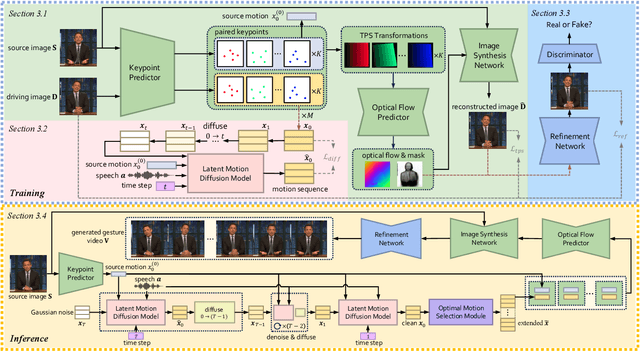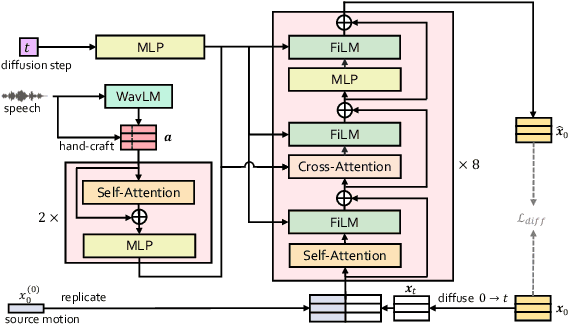Zhensong Zhang
ViDAR: Video Diffusion-Aware 4D Reconstruction From Monocular Inputs
Jun 23, 2025Abstract:Dynamic Novel View Synthesis aims to generate photorealistic views of moving subjects from arbitrary viewpoints. This task is particularly challenging when relying on monocular video, where disentangling structure from motion is ill-posed and supervision is scarce. We introduce Video Diffusion-Aware Reconstruction (ViDAR), a novel 4D reconstruction framework that leverages personalised diffusion models to synthesise a pseudo multi-view supervision signal for training a Gaussian splatting representation. By conditioning on scene-specific features, ViDAR recovers fine-grained appearance details while mitigating artefacts introduced by monocular ambiguity. To address the spatio-temporal inconsistency of diffusion-based supervision, we propose a diffusion-aware loss function and a camera pose optimisation strategy that aligns synthetic views with the underlying scene geometry. Experiments on DyCheck, a challenging benchmark with extreme viewpoint variation, show that ViDAR outperforms all state-of-the-art baselines in visual quality and geometric consistency. We further highlight ViDAR's strong improvement over baselines on dynamic regions and provide a new benchmark to compare performance in reconstructing motion-rich parts of the scene. Project page: https://vidar-4d.github.io
Better Together: Unified Motion Capture and 3D Avatar Reconstruction
Mar 12, 2025Abstract:We present Better Together, a method that simultaneously solves the human pose estimation problem while reconstructing a photorealistic 3D human avatar from multi-view videos. While prior art usually solves these problems separately, we argue that joint optimization of skeletal motion with a 3D renderable body model brings synergistic effects, i.e. yields more precise motion capture and improved visual quality of real-time rendering of avatars. To achieve this, we introduce a novel animatable avatar with 3D Gaussians rigged on a personalized mesh and propose to optimize the motion sequence with time-dependent MLPs that provide accurate and temporally consistent pose estimates. We first evaluate our method on highly challenging yoga poses and demonstrate state-of-the-art accuracy on multi-view human pose estimation, reducing error by 35% on body joints and 45% on hand joints compared to keypoint-based methods. At the same time, our method significantly boosts the visual quality of animatable avatars (+2dB PSNR on novel view synthesis) on diverse challenging subjects.
GASPACHO: Gaussian Splatting for Controllable Humans and Objects
Mar 12, 2025Abstract:We present GASPACHO: a method for generating photorealistic controllable renderings of human-object interactions. Given a set of multi-view RGB images of human-object interactions, our method reconstructs animatable templates of the human and object as separate sets of Gaussians simultaneously. Different from existing work, which focuses on human reconstruction and ignores objects as background, our method explicitly reconstructs both humans and objects, thereby allowing for controllable renderings of novel human object interactions in different poses from novel-camera viewpoints. During reconstruction, we constrain the Gaussians that generate rendered images to be a linear function of a set of canonical Gaussians. By simply changing the parameters of the linear deformation functions after training, our method can generate renderings of novel human-object interaction in novel poses from novel camera viewpoints. We learn the 3D Gaussian properties of the canonical Gaussians on the underlying 2D manifold of the canonical human and object templates. This in turns requires a canonical object template with a fixed UV unwrapping. To define such an object template, we use a feature based representation to track the object across the multi-view sequence. We further propose an occlusion aware photometric loss that allows for reconstructions under significant occlusions. Several experiments on two human-object datasets - BEHAVE and DNA-Rendering - demonstrate that our method allows for high-quality reconstruction of human and object templates under significant occlusion and the synthesis of controllable renderings of novel human-object interactions in novel human poses from novel camera views.
SCENIC: Scene-aware Semantic Navigation with Instruction-guided Control
Dec 20, 2024Abstract:Synthesizing natural human motion that adapts to complex environments while allowing creative control remains a fundamental challenge in motion synthesis. Existing models often fall short, either by assuming flat terrain or lacking the ability to control motion semantics through text. To address these limitations, we introduce SCENIC, a diffusion model designed to generate human motion that adapts to dynamic terrains within virtual scenes while enabling semantic control through natural language. The key technical challenge lies in simultaneously reasoning about complex scene geometry while maintaining text control. This requires understanding both high-level navigation goals and fine-grained environmental constraints. The model must ensure physical plausibility and precise navigation across varied terrain, while also preserving user-specified text control, such as ``carefully stepping over obstacles" or ``walking upstairs like a zombie." Our solution introduces a hierarchical scene reasoning approach. At its core is a novel scene-dependent, goal-centric canonicalization that handles high-level goal constraint, and is complemented by an ego-centric distance field that captures local geometric details. This dual representation enables our model to generate physically plausible motion across diverse 3D scenes. By implementing frame-wise text alignment, our system achieves seamless transitions between different motion styles while maintaining scene constraints. Experiments demonstrate our novel diffusion model generates arbitrarily long human motions that both adapt to complex scenes with varying terrain surfaces and respond to textual prompts. Additionally, we show SCENIC can generalize to four real-scene datasets. Our code, dataset, and models will be released at \url{https://virtualhumans.mpi-inf.mpg.de/scenic/}.
SCRREAM : SCan, Register, REnder And Map:A Framework for Annotating Accurate and Dense 3D Indoor Scenes with a Benchmark
Oct 30, 2024



Abstract:Traditionally, 3d indoor datasets have generally prioritized scale over ground-truth accuracy in order to obtain improved generalization. However, using these datasets to evaluate dense geometry tasks, such as depth rendering, can be problematic as the meshes of the dataset are often incomplete and may produce wrong ground truth to evaluate the details. In this paper, we propose SCRREAM, a dataset annotation framework that allows annotation of fully dense meshes of objects in the scene and registers camera poses on the real image sequence, which can produce accurate ground truth for both sparse 3D as well as dense 3D tasks. We show the details of the dataset annotation pipeline and showcase four possible variants of datasets that can be obtained from our framework with example scenes, such as indoor reconstruction and SLAM, scene editing & object removal, human reconstruction and 6d pose estimation. Recent pipelines for indoor reconstruction and SLAM serve as new benchmarks. In contrast to previous indoor dataset, our design allows to evaluate dense geometry tasks on eleven sample scenes against accurately rendered ground truth depth maps.
Co-Speech Gesture Video Generation via Motion-Decoupled Diffusion Model
Apr 02, 2024



Abstract:Co-speech gestures, if presented in the lively form of videos, can achieve superior visual effects in human-machine interaction. While previous works mostly generate structural human skeletons, resulting in the omission of appearance information, we focus on the direct generation of audio-driven co-speech gesture videos in this work. There are two main challenges: 1) A suitable motion feature is needed to describe complex human movements with crucial appearance information. 2) Gestures and speech exhibit inherent dependencies and should be temporally aligned even of arbitrary length. To solve these problems, we present a novel motion-decoupled framework to generate co-speech gesture videos. Specifically, we first introduce a well-designed nonlinear TPS transformation to obtain latent motion features preserving essential appearance information. Then a transformer-based diffusion model is proposed to learn the temporal correlation between gestures and speech, and performs generation in the latent motion space, followed by an optimal motion selection module to produce long-term coherent and consistent gesture videos. For better visual perception, we further design a refinement network focusing on missing details of certain areas. Extensive experimental results show that our proposed framework significantly outperforms existing approaches in both motion and video-related evaluations. Our code, demos, and more resources are available at https://github.com/thuhcsi/S2G-MDDiffusion.
Low-Res Leads the Way: Improving Generalization for Super-Resolution by Self-Supervised Learning
Mar 05, 2024Abstract:For image super-resolution (SR), bridging the gap between the performance on synthetic datasets and real-world degradation scenarios remains a challenge. This work introduces a novel "Low-Res Leads the Way" (LWay) training framework, merging Supervised Pre-training with Self-supervised Learning to enhance the adaptability of SR models to real-world images. Our approach utilizes a low-resolution (LR) reconstruction network to extract degradation embeddings from LR images, merging them with super-resolved outputs for LR reconstruction. Leveraging unseen LR images for self-supervised learning guides the model to adapt its modeling space to the target domain, facilitating fine-tuning of SR models without requiring paired high-resolution (HR) images. The integration of Discrete Wavelet Transform (DWT) further refines the focus on high-frequency details. Extensive evaluations show that our method significantly improves the generalization and detail restoration capabilities of SR models on unseen real-world datasets, outperforming existing methods. Our training regime is universally compatible, requiring no network architecture modifications, making it a practical solution for real-world SR applications.
Semantics-aware Motion Retargeting with Vision-Language Models
Dec 04, 2023



Abstract:Capturing and preserving motion semantics is essential to motion retargeting between animation characters. However, most of the previous works neglect the semantic information or rely on human-designed joint-level representations. Here, we present a novel Semantics-aware Motion reTargeting (SMT) method with the advantage of vision-language models to extract and maintain meaningful motion semantics. We utilize a differentiable module to render 3D motions. Then the high-level motion semantics are incorporated into the motion retargeting process by feeding the vision-language model with the rendered images and aligning the extracted semantic embeddings. To ensure the preservation of fine-grained motion details and high-level semantics, we adopt a two-stage pipeline consisting of skeleton-aware pre-training and fine-tuning with semantics and geometry constraints. Experimental results show the effectiveness of the proposed method in producing high-quality motion retargeting results while accurately preserving motion semantics. Project page can be found at https://sites.google.com/view/smtnet.
UnifiedGesture: A Unified Gesture Synthesis Model for Multiple Skeletons
Sep 13, 2023



Abstract:The automatic co-speech gesture generation draws much attention in computer animation. Previous works designed network structures on individual datasets, which resulted in a lack of data volume and generalizability across different motion capture standards. In addition, it is a challenging task due to the weak correlation between speech and gestures. To address these problems, we present UnifiedGesture, a novel diffusion model-based speech-driven gesture synthesis approach, trained on multiple gesture datasets with different skeletons. Specifically, we first present a retargeting network to learn latent homeomorphic graphs for different motion capture standards, unifying the representations of various gestures while extending the dataset. We then capture the correlation between speech and gestures based on a diffusion model architecture using cross-local attention and self-attention to generate better speech-matched and realistic gestures. To further align speech and gesture and increase diversity, we incorporate reinforcement learning on the discrete gesture units with a learned reward function. Extensive experiments show that UnifiedGesture outperforms recent approaches on speech-driven gesture generation in terms of CCA, FGD, and human-likeness. All code, pre-trained models, databases, and demos are available to the public at https://github.com/YoungSeng/UnifiedGesture.
The DiffuseStyleGesture+ entry to the GENEA Challenge 2023
Aug 26, 2023Abstract:In this paper, we introduce the DiffuseStyleGesture+, our solution for the Generation and Evaluation of Non-verbal Behavior for Embodied Agents (GENEA) Challenge 2023, which aims to foster the development of realistic, automated systems for generating conversational gestures. Participants are provided with a pre-processed dataset and their systems are evaluated through crowdsourced scoring. Our proposed model, DiffuseStyleGesture+, leverages a diffusion model to generate gestures automatically. It incorporates a variety of modalities, including audio, text, speaker ID, and seed gestures. These diverse modalities are mapped to a hidden space and processed by a modified diffusion model to produce the corresponding gesture for a given speech input. Upon evaluation, the DiffuseStyleGesture+ demonstrated performance on par with the top-tier models in the challenge, showing no significant differences with those models in human-likeness, appropriateness for the interlocutor, and achieving competitive performance with the best model on appropriateness for agent speech. This indicates that our model is competitive and effective in generating realistic and appropriate gestures for given speech. The code, pre-trained models, and demos are available at https://github.com/YoungSeng/DiffuseStyleGesture/tree/DiffuseStyleGesturePlus/BEAT-TWH-main.
 Add to Chrome
Add to Chrome Add to Firefox
Add to Firefox Add to Edge
Add to Edge